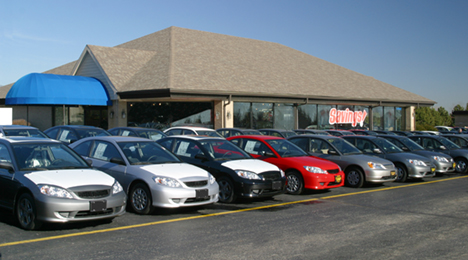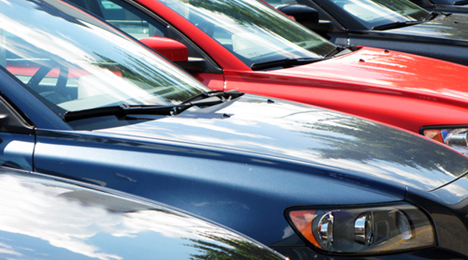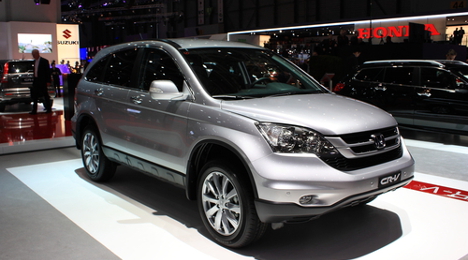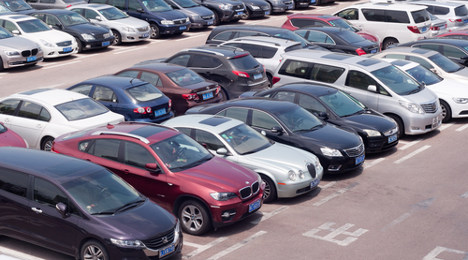Though fall and colder weather may not bring to mind visions of sports cars flying down warm, sunny highways, it seems some shoppers are sick of snow already, as sportier cars are growing in popularity in the used market.
In fact, according to the latest installment of vehicle scarcity data from AutoTrader.com, the Porsche Cayman is the No. 1 most-scarce vehicle nationally for both late-model used and certified pre-owned.
And a variety factors are contributing to the rise in demand for sportier models, and making them a bit harder to find.
“With an improving economy and lower gas prices, it’s ok to buy sporty cars again — as consumers apparently are doing in the used-car market,” said Michelle Krebs, senior analyst at AutoTrader. “The renewed popularity of sporty cars, combined with the fact that not all that many were sold during the drought of the recession years, means used ones are now in short supply.”
Krebs pointed out that the sport-car segment took a “hard hit” after the recession, and was one of the first segments to do so.
“Even if a consumer had the money for a sporty car, conspicuous consumption was not cool in light of so many people struggling economically,” Krebs pointed out.
It has also been one of the slowest segments to rebound, but AutoTrader.com analysts pointed out it is on the upturn in both the new and used markets.
For example, the recent Los Angeles auto show touted a variety of new, sporty, high performance vehicles on display.
And in the used market, a number of sport cars showed up on the scarcity lists for both late-model used and CPO scarcity lists.
Breaking the results down by unit, on top of taking the No. 1 spot on the national lists, the CPO Porsche Cayman is also the most-scarce vehicle in Los Angeles and New York, which Krebs pointed out are the top luxury markets in the nation.
“Other Porsche models, including the Cayenne utility and Boxster, are also scarce,” she added.
Moving on to a domestic car in high demand, the Chevrolet Corvette, which was redesigned last year, came in at the No. 4 scarcest CPO vehicle in the country last month.
The CPO Chevrolet Corvette is in short supply in Washington, D.C., Chicago, Dallas-Fort Worth, Los Angeles and Philadelphia, as well.
Another brand that showed up on the list a considerable amount was Audi, which was no surprise to AutoTrader.
“Audi models of all sort are always in short supply, new and used. The brand is hugely popular among luxury buyers; it is the aspirational luxury brand of Millennials, according to AutoTrader.com’s 2013 millennial study,” Krebs explained.
The flagship A8 came in as the No. 7 most hard-to-find CPO vehicle nationally.
Other models, including the performance-oriented S4 and S5, as well as the less sporty A3 and A5, are in short supply in specific markets, as well, Krebs pointed out.
And though many may not think sport when hearing the name Volkswagen, its sportier Golf R is proving hard to find in Chicago, Dallas-Fort Worth, Houston, New York and Philadelphia.
Other Volkswagen models, including the also sporty GTI, are also in short supply.
“Volkswagen just introduced a new Golf and is rolling out variants thereof, resulting in a scarcity of the sporty Golf R,” Krebs said.
Subaru has also been showing up on the scarcity lists for its sportier models.
“Subaru is another brand that has been enjoying tremendous success in new and used-car sales. The recent redesign of the sporty version of the compact Impreza— the Impreza WRX — has meant tight supplies of used versions, nationally and in specific markets like Boston and New York where all-wheel drive is popular (as is Subaru in general),” Krebs said.
And the sporty Mazda Miata continues to draw loyal followers, as well, especially since a new version is going on sale, which Krebs said is “likely having a halo effect on the used market.”
Stay tuned to Wednesday's Auto Remarketing Today for the full CPO and late-model used scarcity charts for October from AutoTrader.com.

Dealers who participated in KeyBanc Capital Markets’ monthly automotive retail industry update survey gave some candid comments about their used-vehicle prospects, especially in light of 44 percent of respondents saying they expected gross profit per unit to soften by about $50.
Despite that gross-profit expectation, the vast majority of dealers surveyed in September (78 percent) told KeyBanc that they projected year-over-year used sales to rise this month. Of that amount, a third thought that sales would climb between 5 percent and 10 percent, while another third said that the increase would be up to 5 percent.
Among the comments KeyBanc shared, the perspective of used-car managers who participated in the firm’s monthly project covered a wide array of dealership elements, but many focused on inventory and gross profit.
“My inventory levels were just right. We re-price inventory on an ongoing basis, but our gross profit per unit is relatively stable,” one dealer said.
“We didn’t experience any impact. Our Inventory was good in 3Q, and we didn’t see any real impact,” another dealer stated.
“Maybe a couple hundred dollars lower than last year, but I’m new to this store,” yet another mentioned about gross profit.
The connection between inventory and gross profit continued in KeyBanc’s survey, which prompted analysts to say they “remain bullish on the outlook” for dealers.
“We could’ve used more cars, but gross profit per unit was about the same,” a dealer told analysts.
“A little pressure in prices, but no real push on our inventory position,” another dealer added.
One store shared about how what vehicles were on the lot didn’t give the dealership a good chance to succeed.
“Wrong kind of inventory. Too old. Too many miles,” the dealer said. “No impact on gross profit.”
Meanwhile, one dealer comment showed some recent successes — and the strategy of how the store obtained them.
“Our gross profit per unit went up $488 compared to last year,” the dealer said. “If a car doesn’t sell within 20 days, we immediately re-price. We don’t wait.”
The final two dealers who shared how their stores are performing with KeyBanc also touched on inventory.
“Not enough cars was our experience,” a dealer said. “We actually went up in gross profit — more than $100.”
The last dealer acknowledged, “Yes, prices are coming down, but not anymore than normal.”
Beyond the direct dealer comments, KeyBanc’s monthly survey also highlighted dealer sentiment about F&I gross profit, how subprime borrowers are being financed as well as elements of the new-vehicle department.
The majority of dealers surveyed (67 percent) told the firm that F&I gross profit is on track to increase by less than $50, while another 22 percent saw that figure softening by about $50.
A total of 56 percent of dealers indicated conditions for subprime financing was staying the same as only 11 percent saw finance companies tightening their underwriting for potential buyers in this credit tier.
Finally on the new-car side, 56 percent think gross profit per new model turned would be staying flat while the remainder split evenly between that figure increasing or decreasing by $50 or less.
A substantial portion of dealers surveyed (44 percent) said they see automaker stair-step incentive programs remaining stable while another 33 percent thought OEMs are ramping up these initiatives.
Along with giving some hints as to where the Manheim Used Vehicle Value Index might be trending — as well as what this year’s record amount of recalls did to the remarketing of rental risk units — chief economist Tom Webb explained why new-vehicle leasing is going to have a greater impact than the market might have expected.
During his quarterly conference call this week, Webb cited J.D. Power data that showed new-vehicle leasing has increased year-over-year by at least 10 percent during the past 10 quarters — seven of which had spikes of at least 20 percent.
“I get the sense that many people don’t appreciate how leasing has continued to grow this year even though the percentage increases in new-vehicle sales are substantially less,” Webb said. “People are very focused on the so-called wave of off-lease units coming next year and in 2016.
“But I think they fail to recognize that won’t even be the crest,” he added.
Manheim’s current projection has off-lease volume approaching 3.5 million units in 2017, but Webb admitted he and the rest of the analyst team are likely to adjust that estimate.
“We’re certainly going to exceed 3.5 million units and get very close to the all-time high in terms of actual units,” Webb said.
All of this off-lease volume means a bumper crop of vehicles that can be certified. That’s great news for the CPO market, which is coming off of its best sales quarter ever.
“It certainly offers an ideal opportunity for the dealers who are still doing extremely well in the CPO market,” Webb said. “The total off-lease wholesale supply, you’re talking growth of about 20 percent this year, next year and the year following, and probably another double-digit increase in 2017, which probably will have to be revised up since lease originations are higher than I anticipated.
“It’s very broad-based. There’s a lot of mainstream models as well as luxury units, which always have a high-number of off-lease volume coming back,” he added.
General Index Moves
During each call, Webb maintains two points about the Manheim Index. He reminds industry observers that the index reflects a dollar amount and not a residual percentage and it should move on an upward drift.
Also, he doesn’t make exact predictions about where the index reading might land.
However during this week’s call, Webb did discuss the previous times index readings fell below that general upward drift trend line during the 20-year history of the index.
Webb said that the first time it happened came in July 2002, and the index reading settled below the trend line for a little more than three years with the widest point of deviation being 8.5 percent.
“This was a period characterized by heavy lease returns and tightening credit conditions,” Webb said.
The next occurrence happened in October 2007 and lasted just short of two years with the widest point of deviation being 16 percent.
“This was of course the period that included the Great Recession and the total freeze up of the credit markets,” Webb said.
Webb acknowledged September’s reading of 121.4 marked a decline of 1.1 percent compared to a year ago and created the third time the index dipped below that trend line.
So how long will this index trend last? Webb offered a bit of clarity.
“Given the coming increase in wholesale supply, most notably off-lease units, most people believe prices will remain below the trend line for a considerable period of time,” Webb said. “Given that the underlying economic and industry fundamentals are vastly different today than they were in those earlier periods, I would suggest that the deviation from the trend line may be less than in the past.
“Yes, increased wholesale supplies will cause prices to fall. But they won’t cause them to collapse,” he continued. “That would require a simultaneous deterioration in either labor markets or credit conditions, neither of which appears imminent.”
So Webb offered this hypothetical situation: This cycle producing a 5-percent dip below the trend line during the closing quarter of this year.
“That would mean the low point would be a reading of about 116 or 117, about 4 percent lower than today,” Webb said.
“But again, I don’t forecast the index,” he added.
Rental Risk Units and Recalls
Manheim indicated prices rental-risk units fell again in September.
Webb determined that after accounting for broad changes in mix and mileage, prices for rental risk units softened by 4.5 percent from a year ago. He mentioned average mileage crept back up above 40,000, and volumes sold increased.
Webb shared these trends in light of this year’s record number of recalls impacting rental-risk remarketing, a topic Auto Remarketing explained with a pair of auction executives.
“In terms of remarketing rental risk units, this year has been an unusual year with one issue being the impact of recalls,” Webb said. “In the early part of the year, you had a situation where the recalls were increasing the demand in the rental fleet for loaner vehicles. Then more recently the bigger impact has been the fact of delaying some of the remarketing of those vehicles.
“Some of the remarketing of these units has been pushed back into what is a normal seasonal downward movement in pricing. Statistically, it’s not the best time to be remarketing vehicles but that’s the way things have gone,” he added.
As new-vehicle sales continue to grow, an ever-increasing number of off-lease and trade-in vehicles are returning to dealers. According to data provided by AutoTrader, certified pre-owned vehicle inventory has increased by 6 percent since March, 80 percent of which are non-luxury vehicles, totaling to 380,758 vehicles.
What will buyers be looking for? Here are a few of the big hitters from the last few years that are returning to lots in big numbers, as well as commentary from AutoTrader.com analysts.
Great Choices in Used & CPO Vehicles for Each Segment, According to AutoTrader:
- 2011 Ford Fusion: The Ford fusion has been a favorite of ours for many years because it combines several desirable qualities. It's good-looking, has a well-designed interior, is reasonably fun to drive and has enough space that a small family can use it every day. There are also several versions of the Fusion to pick from including a fuel sipping hybrid, almost as good 4-cylinder engine and a V6 version that give the Fusion a sport sedan feel.
- 2011 Honda CR-V: This small SUV essential defines the segment. It's popular, functional and is the perfect no-nonsense car for those who want lots of cargo space and like the elevated seating position of an SUV, but don't want a big truck. Honda's notorious reliability is a big reason this compact SUV is on our list.
- 2010 Toyota Highlander: Like the CR-V, the Toyota Highlander defines the midsize, 3 row SUV. It isn't fancy, but the Limited version has luxury-like features such as leather and a navigation system. But it's the mid-price Sport version that offers the best value. Not too big, not too small, the Highlander is the go-to "just right" family friendly vehicle.
- 2011 Toyota Corolla: This reliable little car has been around since the 1960s and has become the world's best-selling single model, surpassing even the VW Beetle. Efficient and affordable the Corolla is perfect for first time buyers, college students, and seniors on a fixed income as well as young families who need a good car at a low price. Again, like some of the other car on this list, the Toyota Corolla is the textbook definition of "good compact car." Features like power accessories, cruise control and available automatic transmission make the compact Corolla easy to live with even if your automotive aspirations are more Lexus than Toyota.
According to AutoTrader.com, these are all top sellers within their brands, meaning there are a lot of them out there.
"Consumers are armed with a lot of information these days – that means they know the value of a CPO or used car," said Brian Moody, AutoTrader.com site editor. "All of these are priced at about $25,000 or less you can expect these models to fly off lots for great rates and consumers to grow an appetite for used cars throughout 2014 and 2015."
As summer was coming to a close, AutoTrader.com’s vehicle scarcity data experienced “significant shakeups” in August, the site reported to Auto Remarketing.
Interestingly, the shifts were primarily due to renewed interest in models new to the list, rather than a decline in interest in the models that dropped off, according to the site’s analysis.
Riding out the summer in style, the CPO Honda S2000 topped the national CPO scarcity list.
For the late-model used vehicles, the Scion FR-S moving into the No. 1 position nationally as well as placing high in three of the designated market areas AutoTrader.com tracks.
And with all the recent hype about the new 2016 Mazda Miata, it seems interest for the much-loved model is growing even more.
The CPO Mazda Miata came in at No. 3 in Philadelphia and No. 9 in Washington, D.C., on the scarcity lists by DMA.
"As a brand, Mazda continues to generate buzz among price-concious shoppers looking for a stylish vehicle with low total cost of ownership. And with the reveal of the 2016 Mazda MX-5 Miata, it’s not surprising to see the CPO model drawing strong interest amid short supply,” said Juan Flores, director of operations for Trade-In Marketplace at AutoTrader.com.
But the trends weren’t all new. Certain Audi models continued to be particularly hard for dealers to find.
In fact, Audi models were the most scarce vehicles in six of 10 DMAs for the CPO segments touted the most representation in the national scarcity top 10, with three models showing up on the list.
Big Trucks Catching Shoppers’ Eyes
According to AutoTrader.com data, trucks were very popular — and in short supply — in several DMAs in August.
This may not come as a surprise, as trucks — especially pickups — experienced unusually strong price retention in the lanes during the first half of the year. Prices have just started correcting in the lanes.
"Interest in full-size trucks is strong across the board, primarily driven by continued strength in the residential sector, which has created excess demand for heavy-duty variants,” said Flores. “As an effect, this high demand has bolstered prices for pre-owned models across the segment, enabling full-size trucks to outperform in terms of resale value, which is 6 percent higher this month versus the same time last year."
And a few DMAs, in particular, proved hotbeds for truck interest this past month.
For example, shoppers in Los Angeles ramped up interest in trucks considerably, as none of the used and CPO trucks seen on the lists this past month showed up in July.
On the used list for Los Angeles, the Chevrolet Silverado 3500 came in at No. 2; the GMC Sierra 2500 came in at No. 3; the Ford F350 came in at No. 6; the Ram 2500 came in at No. 8; and the Ford F250 came in at No. 9.
Two CPO models also proved hard to find in the area: The CPO Chevrolet Silverado 2500 came in at No. 3, and the CPO GMC Sierra 1500 came in at No. 8.
Philadelphia was another strong DMA for truck interest, and the supply was low enough to land three trucks in the top 10 most scarce vehicles on both the CPO and used lists, AutoTrader.com pointed out.
The CPO Dodge Ram 2500 truck came in at No. 5; the CPO Ford F250 came in at No. 6 and the CPO Ford F350 came in at No. 8.
For used trucks in Philly, the Ram 3500 came in at No. 6; the Ford Explorer Sport Trac came in at No.9; and the Ram 2500 came in at No. 10.
Trucks also proved popular for the following areas.
- In Boston, the CPO Ford F350 came in at No. 5; the CPO Chevrolet Silverado 2500 came in at No. 6; and the CPO GMC Sierra 2500 came in at No. 9. The Sierra 2500 also came in at NO. 9 on the used scarcity list in that DMA.
- In Houston, the CPO Ram 3500 truck came in at No. 9; and the CPO Ford F250 came in at No. 10. On the used scarcity list in Houston, the GMC Sierra 2500 came in at No. 7. None of these vehicles appeared on the scarcity list in that DMA in July.
- In San Francisco/Oakland/San Jose, the used GMC Sierra 2500 came in at No. 3, and the Chevrolet Silverado 2500 coming in at No. 9.
- In Washington, D.C., the CPO Ram 2500 came in at No. 8, while the used Ram 2500 came in at No. 8 on the late model used list. The GMC Sierra 2500 came in at No. 9.

The pool of vehicles in the U.S. is getting larger.
As of June 30, there were more than 249 million cars on American roads — and the average age of these vehicles inched up from where it was a year ago.
That’s according to the latest Experian Automotive Quarterly Briefing released this week, which dissected vehicles in operation data along with a whole host of used-car market metrics.
The report indicates there were 249.4 million vehicles in operation during the second quarter (as of June 30), compared to 247.9 million a year earlier.
Just over a quarter of the cars on the road (25.2 percent) are from model-year 2010 or later, and 93.3 million vehicles are in what Experian called the “sweet spot” — model-years 2003 through 2009.
The average age of cars on the road in Q2 was 11.0 years, up from 10.9 in Q2 of 2013. However, the 15-year rolling age dipped from 7.7 years to 7.6.
The report also dives into year-to-date vehicle registrations. In the first half of 2014, there were 20.36 million used-vehicle registrations, down from 20.71 million in the same period of 2013.
New-vehicle registrations, however, climbed from 7.96 million to 8.29 million.
The seasonally adjusted annualized rate of new-vehicles recently eclipsed a more-than-eight-year high, reaching 17.5 million units in August, according to the latest edition of Guidelines from NADA Used Car Guide.
And one of the offshoots of a stronger new-car market has been a boost in trade-ins, and this impact has trickled down into the auction arena, NADA’s report indicates. Not to mention, hefty gains in the off-rental channels are leading to volume gains at auction, as well.
Jonathan Banks, senior director of vehicle analysis and analytics at NADA, says in the report that more and more of these trade-ins at dealerships are “gradually ending up at auction.”
In fact, Banks points out there was a 2-perecent gain, on average, in the combined auction sales of 2006 through 2010 model-year units in July and August.
“More significantly, 2013–2014 model year volume, comprised largely of off-rental supply, has also been trending up over the past two months,” said Banks, referring to July and August. “Following weeks of declines, volume for the duo shot up by 12 percent on a monthly basis in July and another 14 percent in August.”
Fitch Ratings addressed much of this in its analysis released in September, as well.
“We expect used-car values to further weaken as off-lease and fleet volumes rise and sales of new vehicles continue to be strong,” Fitch analysts said in its report from earlier this month. “Today automakers reported that light vehicles sales rose by 6 percent in the past 12 months and that the seasonally adjusted annualized selling rate reached its highest level since January 2006.”
As the new-vehicle SAAR hit its highest level since 2006 this July, Fitch acknowledged vehicle trade-ins entering the secondary market increased.
“Additionally, incentive spending remains high. Cash, interest rate subvention and longer loan terms providing for lowered payments have fueled sales, making new-vehicle purchases more attractive,” analysts said.
Editor's Note: Staff Writer Nick Zulovich contributed to this report.
The turn rates for dealers on their used cars have been steady with year-ago figures, according to Edmunds.com, which also explained the recent changes in the pre-owned supply-to-demand ratio and how they have impacted turn times.
Edmunds said in its Q2 Used Vehicle Market Report that days-to-turn on used cars during the second quarter was at 37, steady with the turn rate from Q2 of 2013. Likewise, the turn rate for the first quarter was 42 days, same as the year-ago period.
“Q2 witnessed high prices and quick turnover which is a seasonal norm. We expect the market to normalize in the summer as we get further into the model year,” Edmunds’ report indicated. “Newer used-vehicle prices contend with new-vehicle rebates as car shoppers seek out good deals.”
The report goes on to note the hike in new-car sales over the last four years and how that has left a robust inventory of used cars. At this point, it appears that level of supply is moving closer to aligning with consumer appetite, Edmunds said. And that impacts turn rates.
“This increase in used-vehicle supply appears to be nearing an equilibrium with demand of the used vehicle buyers as we see days-to-turn figures that are beginning to level off,” Edmunds noted.
Title washing — the process of altering vehicle documents to remove unsavory details about a vehicle’s past from its title — is an increasing threat to the integrity and safety of the used-car industry in the United States.
According to a report released this week from researchers at Carfax, an estimated 800,000 used cars in the U.S. may be plagued by this issue, unbeknownst to their owners.
So what exactly can be covered up by this “title washing” practice?
The answer is daunting: pretty much anything that would probably make the average buyer walk away from a deal. Salvages. Flood damage. Rolled-back and non-functioning odometers. Many of these vehicles are repaired outside of the states where they’re sold, putting potential buyers looking for a deal at risk of financial and bodily harm.
The company claims the states hardest hit are New Jersey, North Carolina, Mississippi, California and Georgia — but that thousands of title washed vehicles could be in every state. More than 500 could be used as taxis.
Larry Gamache, Carfax’s communications director, believes looking into a vehicle’s history is one of the most key safety measures anyone looking to buy can make.
“Our research is clear evidence that title washing continues to fly under the consumer’s radar,” Gamache said. “These cars are sold mainly by perfect strangers who bank on you not taking the proper steps to protect yourself.”
On the dealer side, the responsibility is two-fold. Not only is it a good idea to find ways, such as providing a vehicle-history report, to assure wary used-vehicle buyers and maintain your reputation and integrity to your customer base, but it’s also the best way to protect your investments. Preventing title washed vehicles from being traded in or from going to auction is one key to saving money for everyone involved and potentially protecting the lives of those that drive your business.
For more information on Carfax and its services, visit their site here.
Lease return numbers could soon double the amounts seen just last year and one auction group, in particular, said it is taking measured steps to meet the surge in supply.
In the group’s latest newsletter, ServNet president Patty Stanley says the network of auctions is ready for the 2.5 million lease returns expected to hit the remarketing industry next year and the 3 million-plus returns predicted the year after that.
“Once thought to be nearing extinction during the downturn in the market, vehicle leasing has re-emerged with new vitality,” said Stanley. “The high number of new-vehicle leases written in 2010 was a positive sign that the economy was on the upswing, and as a result, we're seeing increasingly high volumes of returns hitting the market.”
“ServNet auctions in all parts of the country are reporting substantially larger numbers of lease returns this year over last, and all indicators point to a significant surge in volume in 2015, approaching 2.5 million cars and trucks,” she continued. “By 2016, forecasters are predicting lease returns to top the 3 million mark, nearly double the volume recorded in 2013.”
Granted, such increases in volumes are not without challenges. But Stanley says ServNet’s auctions are prepared.
She points to the facility upgrades members have made, the technological upgrades as well as the fact that the group has been at the “forefront” of the multiplatform selling initiative in developing Hub technology. And the latter offers great exposure for these off-lease units coming in.
“Whether needing to process a single lease return to a thousand, any one of the 30 auctions in the ServNet auction group is prepared,” said Stanley. “With years of experience and proven success, each auction has a ready market, with a loyal, established buyer base and a team that stands ready to implement the most effective remarketing strategy.”
One example of a ServNet auction’s adaption to increased volume has been at Flint Auto Auction, which has begun an expansion project, whose design is to end up adding 27 acres of vehicle parking space and 8,000 square feet of office space.
The auction bought two adjacent properties, kicked off construction this summer and will roll out phase II this fall.
“The timing on the property acquisition was ideal, allowing us to prepare additional acreage for the lease returns which are showing marked increases and will continue to expand into the coming year,” said co-owner Bill Williams. “In addition to making way for additional vehicle storage, we were also able to add 118 more spaces for customer parking, to accommodate the increasing numbers of people who attend the auction every week to buy and sell in the lane.”
The new North Lot at Flint Auto Auction makes up the largest area of expansion. It includes 20 acres and is located about four miles from the main facility. It is utilized for storage and marshaling operations. There is also a 1,300-square-foot office on the property featuring offices for the Flint's Ally Financial and General Motors departments, as well as for the representatives for those accounts.
Phase II will include 8,000 square feet of office space for 18 offices, a conference room and a break room. The auction’s marketing and accounting departments, IT, legacy floor plan, human resources and arbitration departments will be located there.
“We're happy to report that at Flint Auto Auction we continue to grow our facilities right along with the services we provide to our customers,” said Williams. “We are proud of what we have accomplished in our 60-plus years of business, but our focus is on continued success for our remarketing partners.”












